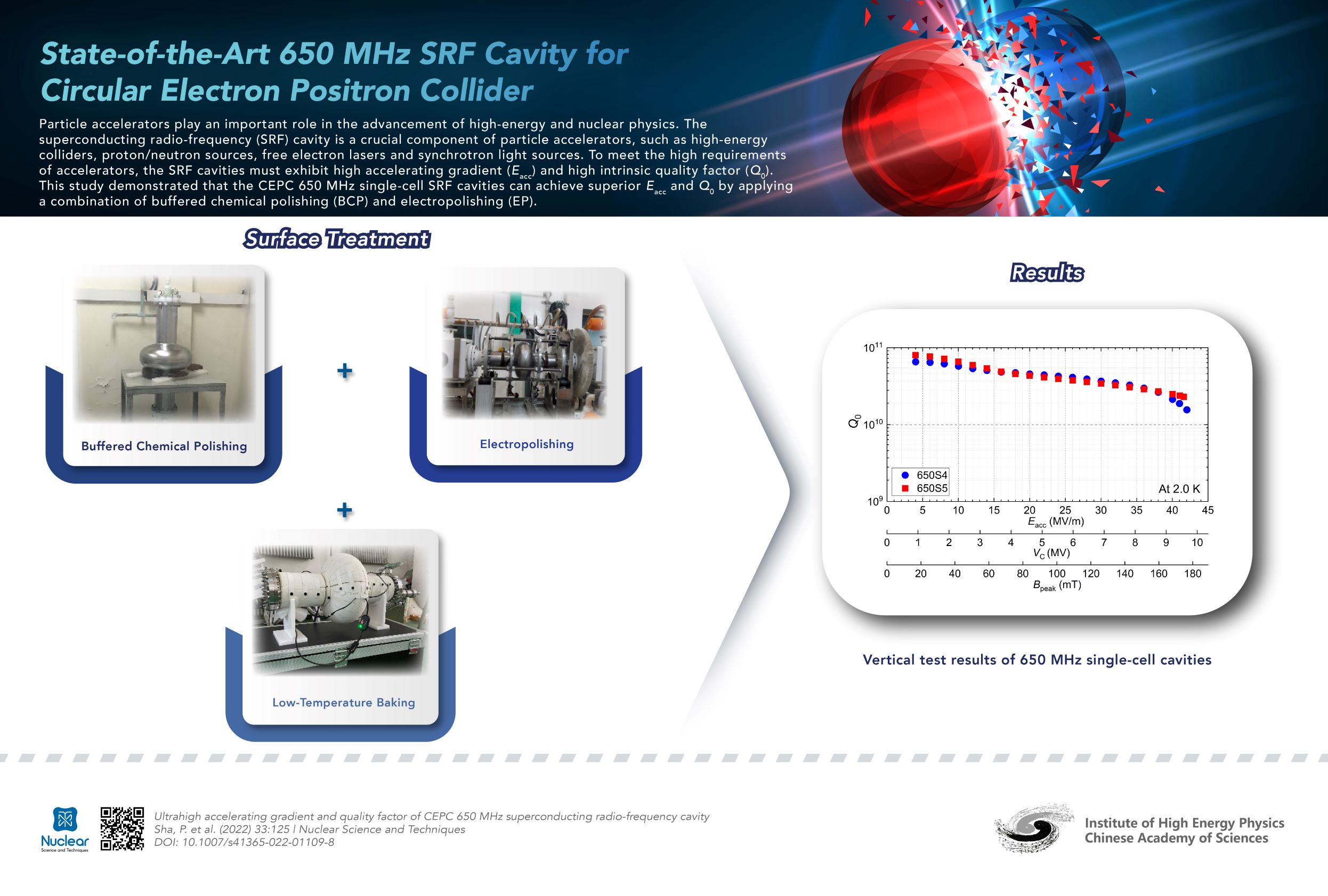博文
达到超高加速梯度的650 MHz超导腔
|
Article Title:Ultrahigh accelerating gradient and quality factor of CEPC 650 MHz superconducting radio-frequency cavity
超高加速梯度和品质因数的CEPC 650 MHz超导腔
DOI:10.1007/s41365-022-01109-8
One sentence summary:
一句话概要:
650 MHz SRF cavities could achieve ultrahigh accelerating gradient after being treated by a combination of buffered chemical polishing (BCP) and electropolishing (EP).
650 MHz 超导腔经过缓冲化学抛光(BCP)和电抛光(EP)的组合处理后,获得了超高的加速梯度。

The Novelty (What)
创新性(主要内容)
This study demonstrated that the Circular Electron Positron Collider (CEPC) 650 MHz single-cell superconducting radio-frequency (SRF) cavities could achieve ultrahigh accelerating gradient (Eacc) by applying a combination of buffered chemical polishing (BCP) and electropolishing (EP). The values of Eacc achieved were above 40 MV/m. Besides, after medium-temperature furnace baking, the SRF cavities achieved an ultrahigh Q0 of 8 × 1010 at 22 MV/m and an extremely low BCS resistance (RBCS) of ~1.0 nΩ at 2.0 K. Two 650 MHz SRF cavities were involved throughout the process of validating the effect of the combination of BCP and EP. By showing the pivotal roles of surface treatments on the performance of SRF cavities, the research output paved a clear path for future research on large SRF cavities.
研究发现,采用缓冲化学抛光(BCP)和电抛光(EP)相结合的方法,环形正负电子对撞机(CEPC)的650 MHz single-cell超导腔可以达到超高的加速梯度(Eacc):加速梯度超过了40 MV/m。 此外,经过中温退火处理后,在2.0 K温度下,650 MHz超导腔的Q0高达8 × 1010 @ 22 MV/m,BCS电阻(RBCS)低至1.0 nΩ。本项研究在2只650 MHz超导腔上验证了BCP和EP组合处理的效果,显示表面处理能够显著影响超导腔的性能,该研究成果为今后大尺寸超导腔的相关研究提供了一条清晰的道路。
The Background (Why)
研究背景(主要原因)
The superconducting radio-frequency (SRF) cavity is a crucial component of particle accelerators, such as high-energy colliders, proton/neutron sources, free electron lasers and synchrotron light sources. The Circular Electron Positron Collider (CEPC) is a high-energy collider of the Higgs factory. The collider ring of the CEPC is equipped with hundreds of 650 MHz SRF cavities. To meet the high requirements of accelerators, the SRF cavities must exhibit high accelerating gradient (Eacc) and high intrinsic quality factor (Q0). The cavities are commonly treated by either buffered chemical polishing (BCP) or electropolishing (EP). However, SRF cavities processed by BCP face challenge in achieving high Eacc, owing to the high surface roughness brought about by BCP. On the other hand, although EP could render higher Eacc, it is a complicated process which also involves higher cost. As such, it was speculated that the combination of BCP and EP could be a feasible way for large SRF cavities to achieve high Eacc. To validate the feasibility of the combination of BCP and EP, this study applied the combined treatment on two 650 MHz SRF cavities and excellent results were obtained. Since the treatment procedures can be replicated easily, the output facilitates the advancement of future studies related to SRF.
超导腔是高能对撞机、质子/中子源、自由电子激光器和同步辐射光源等粒子加速器的重要组成部分。环形正负电子对撞机(CEPC)是一台定位于“希格斯工厂”的高能对撞机, CEPC的对撞环将安装几百只650 MHz超导腔。为了满足加速器的高要求,超导腔必须具备高加速梯度(Eacc)和高品质因数(Q0),超导腔通常要经过缓冲化学抛光(BCP)或电抛光(EP)处理。 然而,由于BCP处理后的表面粗糙,超导腔很难达到高加速梯度;另一方面,虽然EP可以获得更高的加速梯度,但过程复杂、成本也更高。 因此,采用BCP和EP的组合可能是大尺寸超导腔获得高加速梯度的一种可行的方法。 为了验证其可行性,本研究对两只650 MHz 超导腔进行了BCP和EP的组合处理,取得了出色的结果。这种处理方法很容易复制,可以促进未来超导腔相关研究的进展。
The SDG impact (Big Why)
SDG影响力(研究意义)
Particle accelerators play an important role in the advancement of high-energy and nuclear physics. The performance of SRF cavities is very critical as they greatly affect the scale and cost of particle accelerators. In order to contribute to the advancement of research related to SRF, this study developed a highly-feasible and remarkable technique which significantly enhanced the performance of 650 MHz SRF cavities. Therefore, its output showed good alignment with UNSDG 9: Industry, Innovation & Infrastructure.
粒子加速器在高能物理和核物理的发展中起着重要的作用。超导腔的性能对粒子加速器的规模和造价有着重要的影响。 为了促进相关研究的进展,本研究发展了非常可行且重要的技术,显著提高了650 MHz超导腔的性能。 因此,它的产出显示出与联合国可持续发展目标9:产业、创新和基础设施的良好一致性。
研究课题组:
中科院高能所射频超导研究团队,主要从事加速器射频超导和低温技术的研究,并在该领域做出多项成果,目前已发表上百篇期刊及会议文章。
https://blog.sciencenet.cn/blog-3474219-1364678.html
上一篇:用于三维束团位置和电荷测量的成熟软件
下一篇:鉴别LaBr3(Ce)探测器的固有辐射本底,实现更优测量